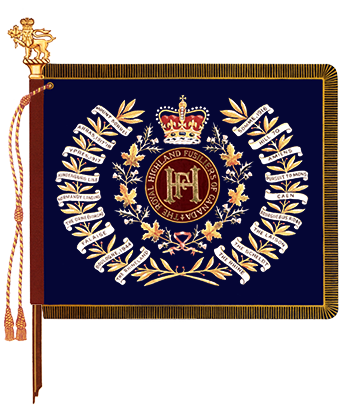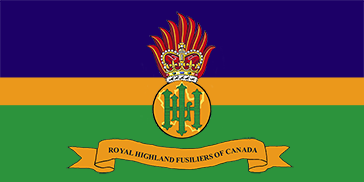The Royal Highland Fusiliers of Canada
The official lineage of The Royal Highland Fusiliers of Canada infantry regiment.

Badge
Description
On the star of the Order of the Thistle Argent fimbriated Azure, a grenade Or fired proper inscribed with the monogram HLI in letters Argent, the flame surmounted by the Royal Crown proper, at the base of the grenade a scroll Azure inscribed with the word CANADA in letters Or above a scroll Azure edged and inscribed with the motto DEFENCE NOT DEFIANCE in letters Or.
Symbolism
The star of the Order of the Thistle is a traditional element associated with highland regiments. The grenade refers to the regiment's fusilier status, while the word CANADA symbolizes the regiment's deep Canadian roots. The monogram HLI was used by The Highland Light Infantry of Canada, which amalgamated with The Scots Fusiliers of Canada in 1965 to form The Highland Fusiliers of Canada. The Crown represents both the regiment's loyal service and the appellation Royal accorded by Her Majesty the Queen in 1998.
Motto
DEFENCE NOT DEFIANCE
Marches
"The Highland Laddie" and "Seann Triubhas"
Alliance
British Army
The Royal Regiment of Scotland
Regimental colour

Camp flag

Battle honours
The First World War
MOUNT SORREL; SOMME, 1916; ARRAS, 1917, '18; HILL 70; YPRES, 1917; AMIENS; HINDENBURG LINE; PURSUIT TO MONS.
The Second World War
NORMANDY LANDING; CAEN; The Orne (Buron); BOURGUÉBUS RIDGE; Faubourg de Vaucelles; FALAISE; The Laison; Chambois; Boulogne, 1944; Calais, 1944; THE SCHELDT; Savojaards Platt; Breskens Pocket; THE RHINELAND; Waal Flats; The Hochwald; THE RHINE; Zutphen; Leer; NORTH-WEST EUROPE, 1944-1945.
South-West Asia
AFGHANISTAN
Lineage
This Reserve Force regiment originated on 14 September 1866 and incorporates the following regiments.
The Royal Highland Fusiliers of Canada originated in Berlin, Ontario on 14 September 1866, when the '29th "Waterloo Battalion of Infantry"' was authorized to be formed.Footnote 1 It was redesignated: '29th Waterloo Regiment' on 8 May 1900;Footnote 2 '29th Regiment (Highland Light Infantry of Canada)' on 15 April 1915;Footnote 3 'The Highland Light Infantry of Canada' on 29 March 1920;Footnote 4 '2nd (Reserve) Battalion, The Highland Light Infantry of Canada' on 7 November 1940;Footnote 5 and 'The Highland Light Infantry of Canada' on 1 May 1946.Footnote 6 On 1 October 1954, it was amalgamated with 'The Perth Regiment' and redesignated 'The Perth and Waterloo Regiment (Highland Light Infantry of Canada)'.Footnote 7 On 1 April 1957, these two regiments ceased to be amalgamated and resumed their former designations.Footnote 8 On 26 February 1965, it was amalgamated with 'The Scots Fusiliers of Canada' (see below) and redesignated 'The Highland Fusiliers of Canada'.Footnote 9 It was redesignated 'The Royal Highland Fusiliers of Canada' on 7 July 1998.Footnote 10
Notes:
Upon redesignation as The Highland Light Infantry of Canada on 29 March 1920 (see above), it was organized as a two battalion regiment with the 1st Battalion (34th Battalion, CEF) on the Non Permanent Active Militia order of battle and the 2nd Battalion (111th Battalion, CEF) on the Reserve order of battle. The reserve unit was disbanded on 14 December 1936 (GO 3/37).
The Highland Light Infantry of Canada was disbanded for the purpose of reorganization on 15 September 1920 and reorganized the same day (GO 253/20). This change was administrative and does not affect the lineage of the regiment.
The Perth and Waterloo Regiment (Highland Light Infantry of Canada) was disbanded for the purpose of reorganization on 1 April 1957 (CAO 78-3, Pt 'B', Supp Issue No. 541/57), and reorganized the same day as two separate regiments (CAO 110-3, Pt 'B', Supp Issue No. 541/57, and CAO 78-3, Pt 'B', Supp Issue No. 626/58). This change was administrative and does not affect the lineage of the regiment.
The Scots Fusiliers of Canada originated in Berlin, Ontario on 21 September 1914, when an "eight company regiment of infantry" was authorized to be formed.Footnote 11 It was designated the '108th Regiment' on 1 February 1915.Footnote 12 It was redesignated: 'The Waterloo Regiment' on 29 March 1920;Footnote 13 'North Waterloo Regiment' on 3 August 1920;Footnote 14 'The Scots Fusiliers of Canada' on 15 September 1928;Footnote 15 '2nd (Reserve) Battalion, The Scots Fusiliers of Canada' on 5 March 1942;Footnote 16 'The Scots Fusiliers of Canada (Reserve)' on 15 October 1943;Footnote 17 and 'The Scots Fusiliers of Canada' on 7 November 1945.Footnote 18 The regiment was converted to artillery and redesignated the '54th Light Anti-Aircraft Regiment (Scots Fusiliers of Canada), RCA' on 1 April 1946,Footnote 19 and converted to infantry and redesignated 'The Scots Fusiliers of Canada' on 1 December 1959.Footnote 20 On 26 February 1965, it was amalgamated with 'The Highland Light Infantry of Canada', as above.
Notes:
Upon redesignation as The Waterloo Regiment on 29 March 1920 (see above), it was organized as a two battalion regiment with the 1st Battalion (118th Battalion, CEF) on the Non Permanent Active Militia order of battle and the 2nd Battalion (no CEF designation) on the Reserve order of battle. The reserve unit was disbanded on 14 December 1936 (GO 3/37).
The North Waterloo Regiment was disbanded for the purpose of reorganization on 1 October 1920 and reorganized the same day (GO 232/20). This change was administrative and does not affect the lineage of the regiment.
Perpetuations
'34th', '111th' and '118th "Overseas" Battalion, CEF'
Headquarters Location
Cambridge, Ontario
Operational history
The First World War
The 34th Battalion, which was authorized on 7 November 1914 as the '34th Battalion, CEF',Footnote 21 embarked for Britain on 23 October 1915.Footnote 22 It provided reinforcements to the Canadian Corps in the field until 27 November 1916, when it was reorganized as the '34th Boys' Battalion, CEF'.Footnote 23 The battalion was disbanded on 17 July 1917.Footnote 24
The 111th Battalion, which was authorized on 22 December 1915 as the '111th "Overseas" Battalion, CEF',Footnote 25 embarked for Britain on 25 September 1916.Footnote 26 On 13 October 1916, its personnel were absorbed by the '35th "Overseas" Battalion, CEF' to provide reinforcements for the Canadian Corps in the field.Footnote 27 The battalion was disbanded on 21 May 1917.Footnote 28
The 118th Battalion, which was authorized on 22 December 1915 as the '118th "Overseas" Battalion, CEF',Footnote 29 embarked for Britain on 22 January 1917.Footnote 30 On 6 February 1917, its personnel were absorbed by the '25th Reserve Battalion, CEF' to provide reinforcements for the Canadian Corps in the field.Footnote 31 The battalion was disbanded on 17 July 1917.Footnote 32
The Second World War
The Highland Light Infantry of Canada mobilized the 'The Highland Light Infantry of Canada, CASF' for active service on 24 May 1940.Footnote 33 It was redesignated the '1st Battalion, The Highland Light Infantry of Canada, CASF' on 7 November 1940.Footnote 34 It embarked for Britain on 20 July 1941.Footnote 35 On D-Day, 6 June 1944, it landed in Normandy, France as part of the 9th Canadian Infantry Brigade, 3rd Canadian Infantry Division, and it continued to fight in North-West Europe until the end of the war.Footnote 36 The overseas battalion was disbanded on 15 January 1946.Footnote 37
The regiment subsequently mobilized the '3rd Battalion, The Highland Light Infantry of Canada, CIC, CAOF' on 1 June 1945 for active service with the Canadian Army Occupation Force in Germany.Footnote 38 The battalion was disbanded on 1 May 1946.Footnote 39
The Scots Fusiliers mobilized the '1st Battalion, The Scots Fusiliers, CASF' for active service on 5 March 1942.Footnote 40 It served in Canada in a home defence role as part of Military District No. 2.Footnote 41 The battalion was disbanded on 15 October 1943.Footnote 42
South-West Asia
From 2002 to 2014, the Royal Highland Fusiliers of Canada reinforced various CAF units deployed to Afghanistan.Footnote 43